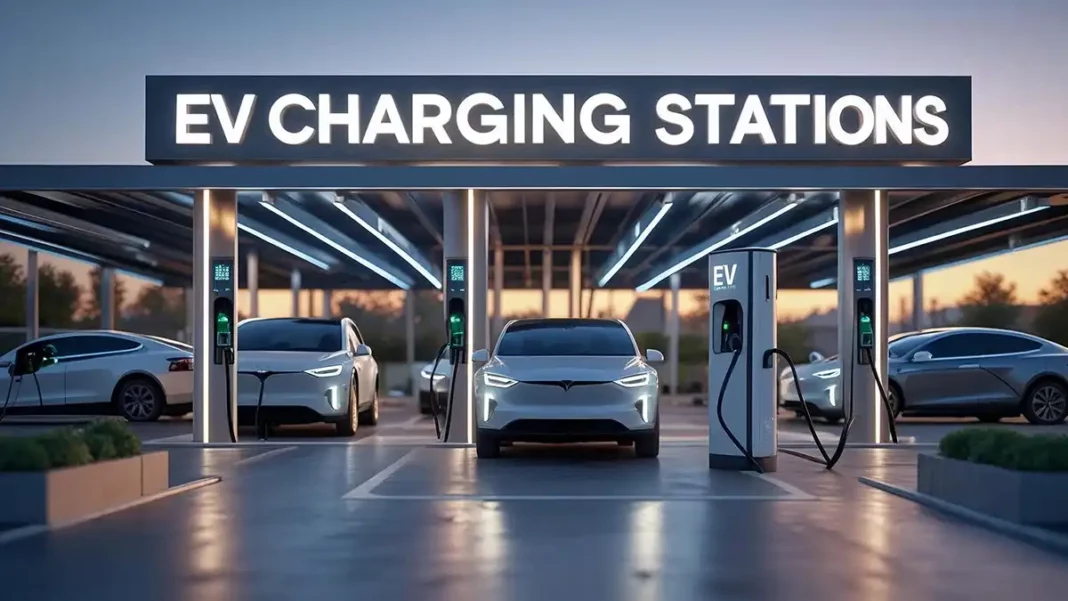The rise of electric vehicles (EVs) is quite changing the landscape of transportation, making EV charging stations an essential component of modern infrastructure. In order to accommodate the growing number of electric vehicles on the road, governments, corporations and communities have prioritized the implementation and expansion of electric car charging stations.
The Growth of EV Charging Stations in the United States
In recent years, the number of EV charging stations in the United States has definitely skyrocketed. Tens of thousands of charging stations are now strategically placed throughout the country for public, business and home use. The majority of EV owners currently charge their vehicles at home, but the availability of public and workplace charging stations for EVs is expected to boost market acceptability and make EVs more feasible for daily use.
In order to enable long-distance travel, electric vehicle charging stations are being installed along key highway routes and in urban areas. The Alternative Fueling Station Locator is an excellent tool for locating electric car charging stations by location or along a route, making trip planning with an electric vehicle quite simple.
Types of EV Charging Stations
Understanding the various types of EV charging stations is essential for both consumers and businesses. There are three types of charging, each with its own set of properties and applications:
AC Level 1 Charging
- Description: Level 1 charging makes use of a regular 120V AC outlet, which is quite widely available in most homes.
- Speed: Offers approximately 5 miles of range each hour of charging.
- Usage: Typically used for overnight home charging or in situations with only one conventional outlet accessible.
- Connector: SAE J1772 connector.
- Prevalence: As of early 2024, around less than 1% of all the public charging stations in the United States are Level 1.
AC Level 2 Charging
- Description: Level 2 charging requires 240V (residential) or 208V (commercial) power and is significantly faster than Level 1.
- Speed: Offers roughly around 25 miles of range every hour of charging.
- Usage: Most commonly used in homes, businesses and public Electric vehicle charging stations.
- Connectors: SAE J1772 or J3400 (NACS for Tesla vehicles).
- Prevalence: Level 2 is the most popular form of public EV charging station in the United States, accounting for about 76% of all installations.
DC Fast Charging (Level 3)
- Description: DC fast charging uses what we call direct current at high power in order to enable rapid charging.
- Speed: Provides 100-200+ miles of range every 30-minute charge.
- Usage: Most commonly encountered on highways and in metropolitan fast-charging stations.
- Connector: Connector types include CCS, CHAdeMO and J3400 (NACS).
- Prevalence: DC fast chargers the unit for more than 20% of public EV charging stations in the United States and this figure is growing as a result of federal support and fleet adoption.
Charging Infrastructure and Technology
The development of charging stations for electric vehicles is quite dependent on advancements in charging technology and infrastructure planning. The industry has mostly aligned with the Open Charge Point Interface (OCPI) protocol, which standardizes terminology and data sharing for electric car charging stations.
Terminology
- Station Location: A physical location having one or more EV charging connections (such as a parking lot or garage).
- EV Charging Port: The real charger that serves a single vehicle at a time.
- Connector: The plug that connects the charger to the car (such as J1772, CCS, CHAdeMO, or J3400).
Charging Equipment
When selecting charging stations or equipment, you must consider charging speed, networking, payment options and maintenance. Charging time varies according to battery size, state of charge and charger power output. For example, a DC fast charger may replenish a battery in about 30 minutes, whereas Level 1 charging may take 20 hours or more.
The Future of EV Charging Stations
The network of electric car charging stations is projected to grow quickly in the next few years. Federal initiatives such as the Bipartisan Infrastructure Act provide money for additional charging stations for electric vehicles, particularly along national highways and alternative fuel corridors. The development of new connector standards, such as the J3400 (NACS), makes charging more universal and accessible to all EV models.
Inductive and Wireless Charging
Inductive (wireless) charging is yet another advancement in electric car charging stations that employs electromagnetic fields to transmit energy without the use of wires. While still in its early commercial stages, this technology is highly promising for fleet operations and public transportation.
Megawatt Charging Systems
Megawatt Charging Systems (MCS) for heavy-duty vehicles are currently being developed, with power outputs of up to 3.75 MW for rapid charging of trucks and buses. This will most certainly transform electric freight and public transit in the near future.
EV Charging Stations and Sustainability
The expansion of EV charging stations is critical for lowering greenhouse gas emissions and accelerating the transition to cleaner transportation. In order to optimize environmental benefits, many new electric car charging stations are powered by renewable energy sources like solar or wind. Community leaders and businesses are largely investing in EV preparedness planning to guarantee that infrastructure keeps up with car adoption.
Finding EV Charging Stations
Drivers can quite easily locate electric car charging stations owing to web tools and smartphone applications. The Alternative Fueling Station Locator allows users to look for public and private Electric car charging stations based on their location, connector type and charging speed. Many apps offer real-time availability and route planning tools to facilitate long-distance travel.
Conclusion: EV charging stations
The evolution of charging stations for electric vehicles is extremely important to the future of electric mobility. With tens of thousands of electric car charging stations already in place and more being installed every day, the infrastructure is expected to keep up with the fast uptake of electric vehicles. DC fast charging, wireless charging and megawatt systems are making it easier and faster to recharge, whether at home, work, or on the go.
In order to ensure a smooth transition to electric mobility, continued investment in EV charging stations is essential. As technology advances and networks expand, drivers will most likely find it easier than ever to locate and use Electric cars charging stations wherever they travel. The move to a cleaner, more sustainable future is already underway, with EV charging stations driving it forward.
FAQs: EV Charging Stations
Q1: How do I find EV charging stations near me?
A: In order to identify nearby EV charging stations, use online tools like the Alternative Fueling Station Locator, which allows you to search by area, route, connector type and charging speed.
Q2: What is the difference between Level 1, Level 2, and DC fast charging?
A: Level 1 operates on a conventional 120V plug and is relatively slow, mostly for domestic use. Level 2 uses 240V or 208V power and is substantially faster, making it widespread in both home and public Electric vehicle charging stations. DC fast charging (Level 3) offers rapid charging, primarily on highways and in urban areas.
Q3: Can all electric vehicles use any EV charging station?
A: Most EVs may use Level 1 and Level 2 EV charging stations equipped with the J1772 connector. DC rapid charging requires connector compatibility (CCS, CHAdeMO, J3400). Many modern automobiles have adapters that boost compatibility.
Also Read:
Upcoming Electric Cars in India: The Future of Mobility in 2025


